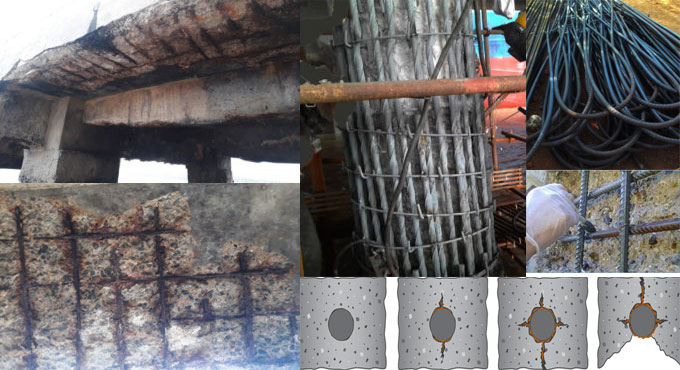In order to resist damage and failure of concrete structures, steel reinforcement Corrosion control methods are undertaken. Near about forty percentage of collapsing of concrete structures occur due to corrosion of inner steel reinforcement.
There are various reasons for the corrosion of steel reinforcement which range from the quality of concrete, atmosphere, and quality of construction practices.

~~~~~~~~~~~~~~~~~~~~~~~~~
There are various reasons for the corrosion of steel reinforcement which range from the quality of concrete, atmosphere, and quality of construction practices.
Initially, it is required to arrange superior quality of concrete via good construction practices to manage corrosion in rebar. To manage rebar corrosion, the focus should be given on various factors like the quality of concrete materials, mixing, placing and compaction methods and good workmanship.
Quality control in concrete construction minimizes the scopes of corrosion. By applying the following methods, the corrosion of reinforcement bar can be controlled efficiently.
Steel reinforcement corrosion control processes :-
• Cement-Polymer Composite Coated Rebars (CPCC)
• Fusion Bonded Epoxy Coated Rebars (FBEC)
• Corrosion Resistant Steel Deformed Rebars (CRSD)
• Fusion Bonded Epoxy Coated Rebars (FBEC)
• Corrosion Resistant Steel Deformed Rebars (CRSD)
1.Cement-Polymer Composite Coated Rebars (CPCC): Cement polymer coat rebar implanted in concrete are encircled through an alkaline medium. A cement base coating is very effective in controlling reinforcement corrosion. Two coats of cement polymer are used on rebar like first Primer coat and a sealer coat.
Products contained in Cement Polymer Composite Coated rebar are:
• De-rusting Solution
• Alkaline Powder
• Phosphating Jelly
• Inhibitor Solution
• Sealing Solution
• Alkaline Powder
• Phosphating Jelly
• Inhibitor Solution
• Sealing Solution
2. Fusion Bonded Epoxy Coated Rebars (FBEC): Fusion bond epoxy coat rebar is formed with 100% solid delicately grounded fuse powder particles. These particles are dissolved through heating to develop a permanent adherent film. There is not any passivating primer film contained in FBEC rebars. It produces a medium of weakness in the path of an intimate bond among rebar and alkaline concrete.
Epoxy provides the coating to the rebar with the following :-
• Melts
• Flows
• Gels
• Cures
• Cools
• Adheres to coating
• Flows
• Gels
• Cures
• Cools
• Adheres to coating
3. Corrosion Resistant Steel Deformed Rebars (CRSD): Under this method, an initial layer of protective oxide or rust is created to resist the corrosion. On general rust on normal rebars, the CRSD rust is passive, persistent and self-renewing. The preventive oxide is fine texture, tightly adherent and a barrier to moisture, oxygen, carbon dioxide, Sulphur dioxide. The chloride provides protection against corrosion.
It is suggested to employ corrosion resistance Steel Deformed Rebars to resist corrosion of concrete structures, damage, and collapsing of concrete structures.
Article Source : www.cforcivil.com

No comments:
Post a Comment